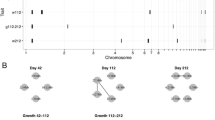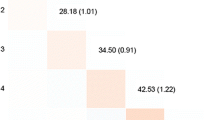Abstract
Components of genetic variation for postweaning growth traits were estimated for both control and growth stocks of mice. The effect of phenotypic selection for gain, which genetically combines selection for additive direct and maternal effects, on additive genetic variance components, heritability, and additive genetic correlationsis discussed. Quantitative genetic theory predicts that simultaneous selection for two metric traits in the same direction will cause the genetic correlation between the two traits to become more negative. The results presented in this paper conflict with this theory. The direct-maternal additive genetic correlation was more negative in the control line (with 356 mice) than in the growth-selected line (with 320 mice) for the three traits analyzed (0.310 vs 0.999 for 21-day weight, 0.316 vs 1.000 for 42-day weight, and 0.506 vs 1.000 for gain from 21–42 days). Estimates were obtained by restricted maximum likelihood (REML) computed under a derivative free algorithm (DFREML).
Similar content being viewed by others
References
Ahlschwede WT, Robison OW (1971) Prenatal and postnatal influences on growth and backfat in swine. J Anim Sci 33:1206–1211
Bradford GE, Famula TR (1984) Evidence for a major gene for rapid postweaning growth in mice. Genet Res 44:293–308
Bulmer MG (1985) The mathematical theory of quantitative genetics. Clarendon Press, Oxford
Cantet RJC, Kress DD, Anderson DC, Doornbos DE, Burfening PJ, Blackwell RL (1988) Direct and maternal variances and covariances and maternal phenotypic effects on preweaning growth of beef cattle. J Anim Sci 66:648–659
El Oksh HA, Sutherland TM, Williams JS (1967) Prenatal and postnatal influence on growth in mice. Genetics 57:79–83
Falconer DS (1981) Introduction to quantitative genetics. 2nd edn. Longman, New York
Friars GW, Bohren BB, McKean HE (1962) Time trends in estimates of genetic parameters in a population of chickens subjected to multiple objective selection. Poultry Sci 41:1773–1783
Hohenboken WD, Brinks JS (1971) Relationships between direct and maternal effects on growth in Herefords. II. Partitioning of covariance between relatives. J Anim Sci 32:26–34
Koch RM, Gregory KE, Cundiff LV (1982) Critical analysis of selection methods and experiments in beef cattle and consequences upon selection programs applied. Proc 2nd World congress on genetics applied to livestock production. Madrid, Spain, Oct. 4–8, pp 514–526
Mather K, Jinks JL (1982) Biometrical genetics. 3rd edn. Chapman and Hall, London
Meyer K (1988) DFREML. Programs to estimate variance components for individual animal models by restricted maximum likelihood. User notes. Edinburgh University, Scotland
Rutledge JJ, Robison OW, Eisen EJ, Legates JE (1972) Dynamics of genetic and maternal effects in mice. J Anim Sci 35:911–918
Sheridan AK, Barker JSF (1974) Two-trait selection and the genetic correlation. II. Changes in the genetic correlation during two trait selection. Aust J Biol Sci 27:89–101
Van Vleck LD, St Louis D, Miller J I (1977) Expected phenotypic response in weaning weight of beef calves from selection for direct and maternal genetic effects. J Anim Sci 44:360–367
Willham RL (1963) The covariance between relatives for characters composed of components contributed by related individuals. Biometrics 19:18–27
Author information
Authors and Affiliations
Additional information
Communicated by L. D. Van Vleck
Rights and permissions
About this article
Cite this article
Swartz, A.R., Famula, T.R. The effects of selection for gain in mice on the direct-maternal genetic correlation. Theoret. Appl. Genetics 89, 392–396 (1994). https://doi.org/10.1007/BF00225371
Received:
Accepted:
Issue Date:
DOI: https://doi.org/10.1007/BF00225371




